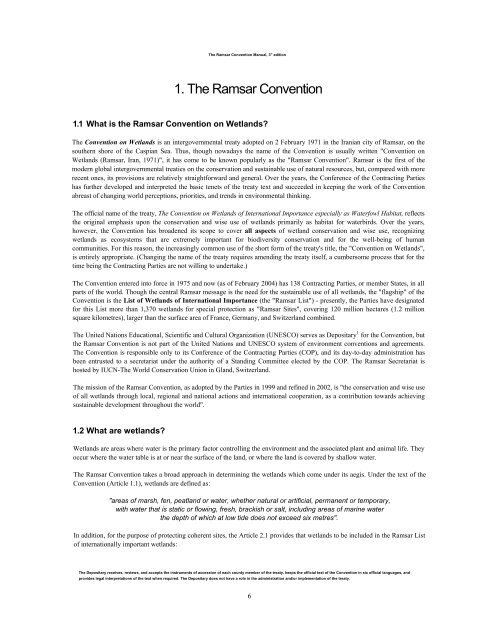The Ramsar Convention Manual.pdf
The Ramsar Convention Manual.pdf
The Ramsar Convention Manual.pdf
You also want an ePaper? Increase the reach of your titles
YUMPU automatically turns print PDFs into web optimized ePapers that Google loves.
<strong>The</strong> <strong>Ramsar</strong> <strong>Convention</strong> <strong>Manual</strong>, 3" edition<br />
1. <strong>The</strong> <strong>Ramsar</strong> <strong>Convention</strong><br />
1.1 What is the <strong>Ramsar</strong> <strong>Convention</strong> on Wetlands<br />
<strong>The</strong> <strong>Convention</strong> on Wetlands is an intergovernmental treaty adopted on 2 February 1971 in the Iranian city of <strong>Ramsar</strong>, on the<br />
southern shore of the Caspian Sea. Thus, though nowadays the name of the <strong>Convention</strong> is usually written "<strong>Convention</strong> on<br />
Wetlands (<strong>Ramsar</strong>, Iran, 1971)", it has come to be known popularly as the "<strong>Ramsar</strong> <strong>Convention</strong>". <strong>Ramsar</strong> is the first of the<br />
modern global intergovernmental treaties on the conservation and sustainable use of natural resources, but, compared with more<br />
recent ones, its provisions are relatively straightforward and general. Over the years, the Conference of the Contracting Parties<br />
has further developed and interpreted the basic tenets of the treaty text and succeeded in keeping the work of the <strong>Convention</strong><br />
abreast of changing world perceptions, priorities, and trends in environmental thinking.<br />
<strong>The</strong> official name of the treaty, <strong>The</strong> <strong>Convention</strong> on Wetlands of International Importance especially as Waterfowl Habitat, reflects<br />
the original emphasis upon the conservation and wise use of wetlands primarily as habitat for waterbirds. Over the years,<br />
however, the <strong>Convention</strong> has broadened its scope to cover all aspects of wetland conservation and wise use, recognizing<br />
wetlands as ecosystems that are extremely important for biodiversity conservation and for the well-being of human<br />
communities. For this reason, the increasingly common use of the short form of the treaty's title, the "<strong>Convention</strong> on Wetlands",<br />
is entirely appropriate. (Changing the name of the treaty requires amending the treaty itself, a cumbersome process that for the<br />
time being the Contracting Parties are not willing to undertake.)<br />
<strong>The</strong> <strong>Convention</strong> entered into force in 1975 and now (as of February 2004) has 138 Contracting Parties, or member States, in all<br />
parts of the world. Though the central <strong>Ramsar</strong> message is the need for the sustainable use of all wetlands, the "flagship" of the<br />
<strong>Convention</strong> is the List of Wetlands of International Importance (the "<strong>Ramsar</strong> List") - presently, the Parties have designated<br />
for this List more than 1,370 wetlands for special protection as "<strong>Ramsar</strong> Sites", covering 120 million hectares (1.2 million<br />
square kilometres), larger than the surface area of France, Germany, and Switzerland combined.<br />
<strong>The</strong> United Nations Educational, Scientific and Cultural Organization (UNESCO) serves as Depositary 1 for the <strong>Convention</strong>, but<br />
the <strong>Ramsar</strong> <strong>Convention</strong> is not part of the United Nations and UNESCO system of environment conventions and agreements.<br />
<strong>The</strong> <strong>Convention</strong> is responsible only to its Conference of the Contracting Parties (COP), and its day-to-day administration has<br />
been entrusted to a secretariat under the authority of a Standing Committee elected by the COP. <strong>The</strong> <strong>Ramsar</strong> Secretariat is<br />
hosted by IUCN-<strong>The</strong> World Conservation Union in Gland, Switzerland.<br />
<strong>The</strong> mission of the <strong>Ramsar</strong> <strong>Convention</strong>, as adopted by the Parties in 1999 and refined in 2002, is "the conservation and wise use<br />
of all wetlands through local, regional and national actions and international cooperation, as a contribution towards achieving<br />
sustainable development throughout the world".<br />
1.2 What are wetlands<br />
Wetlands are areas where water is the primary factor controlling the environment and the associated plant and animal life. <strong>The</strong>y<br />
occur where the water table is at or near the surface of the land, or where the land is covered by shallow water.<br />
<strong>The</strong> <strong>Ramsar</strong> <strong>Convention</strong> takes a broad approach in determining the wetlands which come under its aegis. Under the text of the<br />
<strong>Convention</strong> (Article 1.1), wetlands are defined as:<br />
"areas of marsh, fen, peatland or water, whether natural or artificial, permanent or temporary,<br />
with water that is static or flowing, fresh, brackish or salt, including areas of marine water<br />
the depth of which at low tide does not exceed six metres".<br />
In addition, for the purpose of protecting coherent sites, the Article 2.1 provides that wetlands to be included in the <strong>Ramsar</strong> List<br />
of internationally important wetlands:<br />
<strong>The</strong> Depositary receives, reviews, and accepts the instruments of accession of each county member of the treaty, keeps the official text of the <strong>Convention</strong> in six official languages, and<br />
provides legal interpretations of the text when required. <strong>The</strong> Depositary does not have a role in the administration and/or implementation of the treaty.<br />
6












